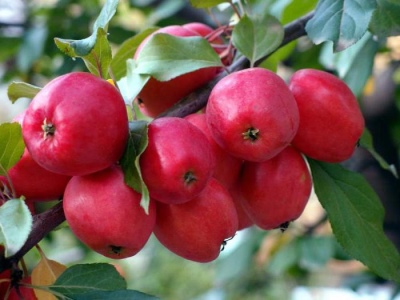
- Authors: William Leslie Kerr (Canada)
- Taste: sweet, with sourness and astringency
- Fruit weight, g: from 20-30 to 45
- Fruit size: small
- Yield: high
- Frequency of fruiting: first annual, then bountiful harvests alternate with moderate
- The beginning of fruiting varieties: for 3-4 years
- Ripening terms: late autumn
- Removable maturity: in September
- Keeping quality: until December-January
Traditionally, the apple tree is considered, if not a southern plant, then a plant associated with a temperate climate. But the Canadian variety Kitayka Kerr defies this conventional wisdom. And therefore, you need to get to know him thoroughly.
Breeding history of the variety
The author of the breeding work was the Canadian specialist William Leslie Kerr. His merits are reflected in the name of the plant. The apple trees Dolgo and Kharalson were taken as the basis for the development of the culture. Although the variety was introduced to the world back in 1952, it retains its relevance. This apple tree is not listed in the Russian official register of agricultural crops.
Description of the variety
It should be noted that abroad he has an alternative name - Malus prunifolia Kerr. The tree is notable for its expressive beauty. It is especially elegant at the moment of budding and flowering. The crown is neat. Spreading is inherent in it, but only to a small extent. Shoots are greenish brown by default.
The leaves are outwardly the same as those of the plum. It can even be easy to confuse them. Kitayka Kerr also has subspecies, differing primarily in the height of mature trees. The higher the specific variant, the longer it lives, and the longer the period of active fruiting. Important: it is undesirable to transplant such apple trees, this is done only in extreme cases.
Features, pros and cons
An important plus is the excellent decorative qualities of the culture. The height of the most common variant is 5 m. No negative aspects have been found in the long history of Kitayka Kerr. But a number of positive points have been confirmed:
early maturity;
the ability to withstand harsh winters;
resistance to dry periods;
minimum requirements for the quality of land;
solid immunity;
excellent gastronomic qualities.
Ripening and fruiting
Chinese Kerr is a typical late autumn apple tree. You can remove the fruits from the branches in September. The first fruits appear at 3 or 4 years of age. In warm climates, you can feast on fruits already in the second half of August. The culture will bloom in April-May.
Growing regions
The shallow and highly branching root system of Kitayka Kerr staunchly manifests itself even in the Far East and Siberia. Drought resistance allows the plant to be planted in the steppe regions. In temperate climates, the use of culture is all the more easy. In warm areas, autumn planting is permissible. The cold climate forces us to limit ourselves to spring planting.
Yield
Yields are stable at first. Gradually, a large collection will alternate with a moderate one over the years. There is no exact data on the amount of fruit. However, reviews show that the plant gives a full collection almost always. Some farmers claim that it is possible to remove up to 120 kg per season.
Fruits and their taste
Kitayka Kerr's apples are universal. They are typically dark red in color. The fruits themselves are slightly elongated. Their taste is sweet, with the inclusion of sour and tart notes. Small apples weigh from 20 to 45 g, their pulp is juicy, and you can keep the harvest until December-January.

Growing features
For Kitayka Kerr, fertile areas with non-acidic soil are needed. The choice between a sunny area and shaded areas is up to the gardeners' preference. There are other important nuances:
it is better to avoid places with high groundwater;
thorough watering should be organized in the first year;
the planting pit should be ready in 1 month;
when planting, it is necessary to lay there 30 kg of humus, 0.3 kg of wood ash, 0.1 kg of superphosphate and 0.12 kg of potassium sulfate;
before planting, it is recommended to soak the roots in warm water, and when immersed in the ground, dip them in a clay chatterbox.



Pollination
The variety does not need pollinators. Moreover, it literally becomes a "magnet" for bees. Therefore, such a plant can be grown on any site without fear.

Frost resistance
Resists cold weather Kitayka Kerr is quite effective. But all the same, shelter is required for the winter (wrapping the trunks). Young seedlings are protected by the tent method. Adult trees are protected with a shelter:
agrofiber;
burlap;
roofing material.

Diseases and pests
Both rodents and insect pests pose a threat to this apple tree. The usual whitewashing of the trunks is capable of stopping them. To prevent infection with parasites, regular proactive spraying with factory mixtures is carried out. Periodically, you have to deal with aphids, leaf beetles and apple moths. The plant is scab resistant, susceptibility to other infections depends on growing conditions.

The apple tree is a popular fruit crop among gardeners. It can be found in many summer cottages. But at the same time, such trees are often affected by various diseases. It is very important to recognize the disease in time and carry out the necessary procedures for a speedy recovery.Otherwise, the fruits will be spoiled, and the tree itself may die altogether.

Review overview
Gardeners note that, despite their small size, the fruits of Kitayanka Kerr are unusually tasty. This variety allows for fairly large harvests. There are no big difficulties with caring for him. The taste is really unusual. Storage is quite convenient, it goes even better than that of the famous Antonovka.











































































